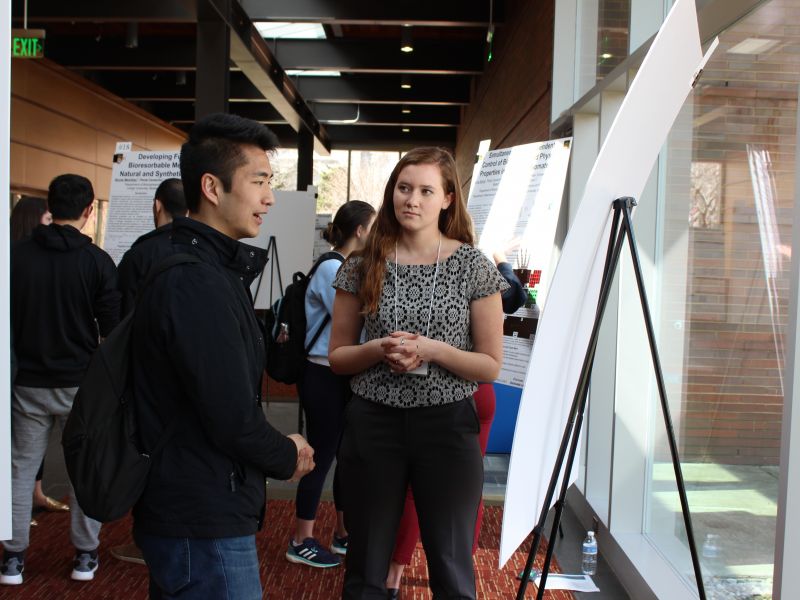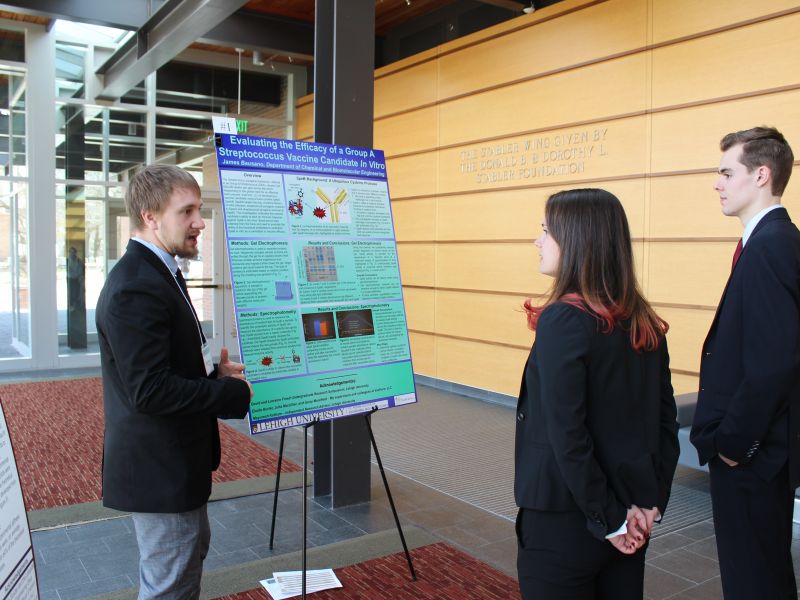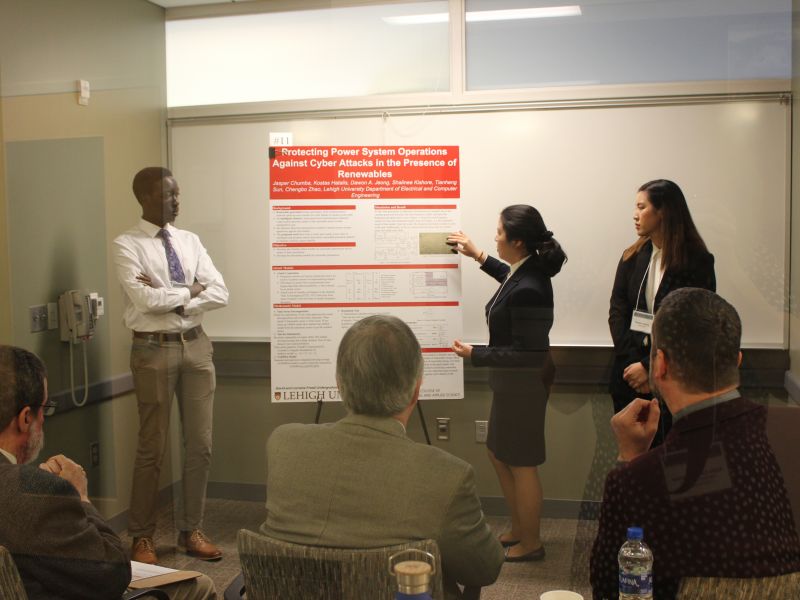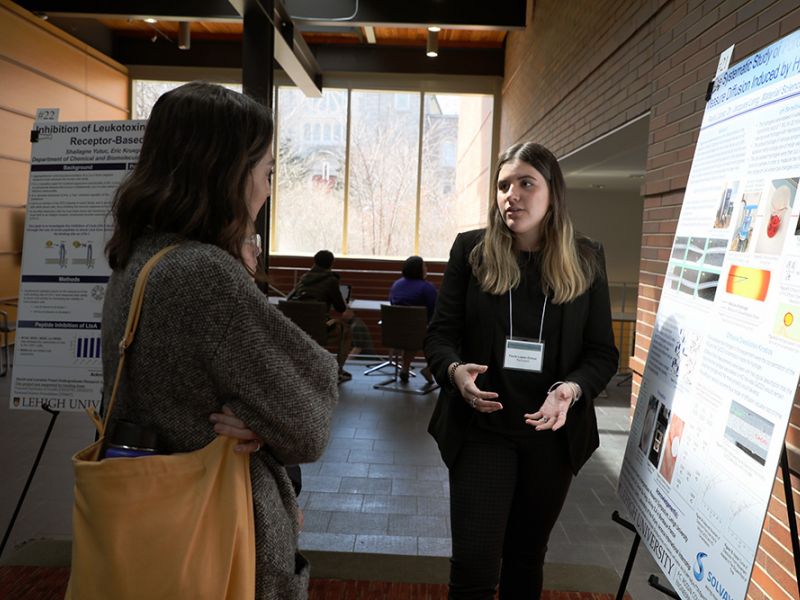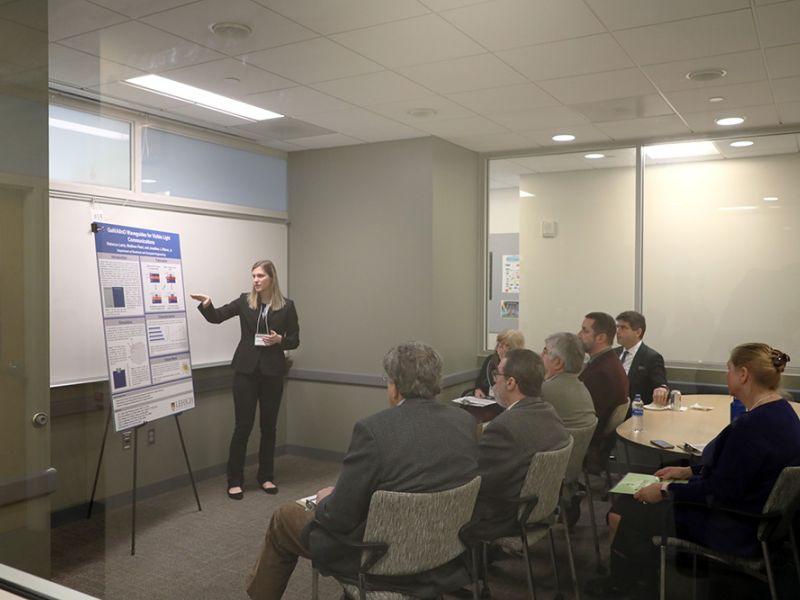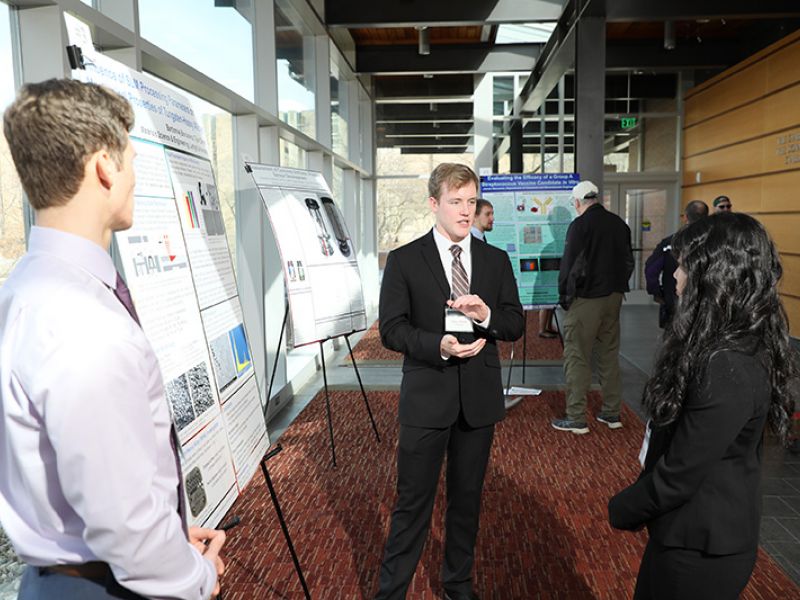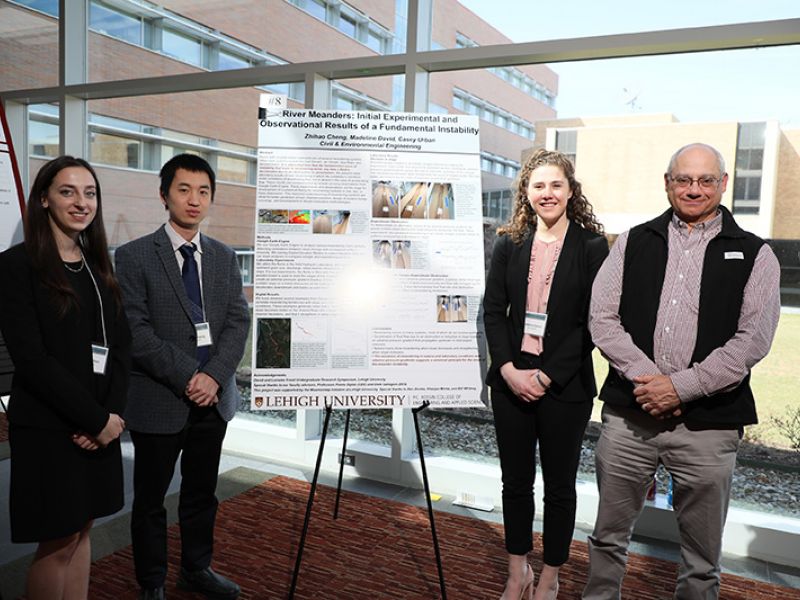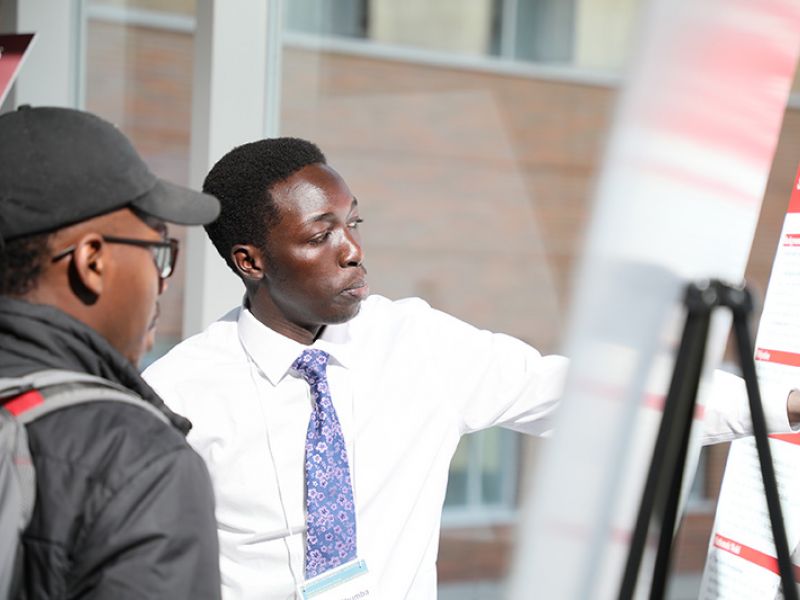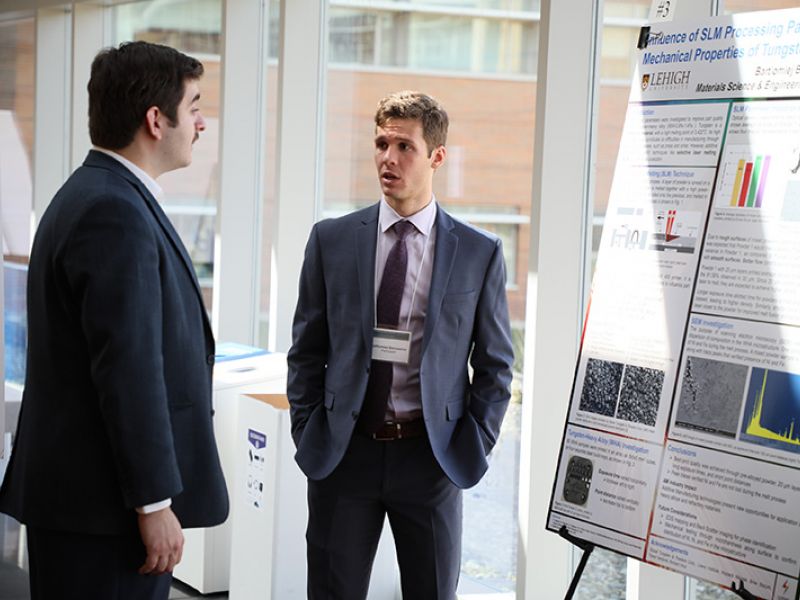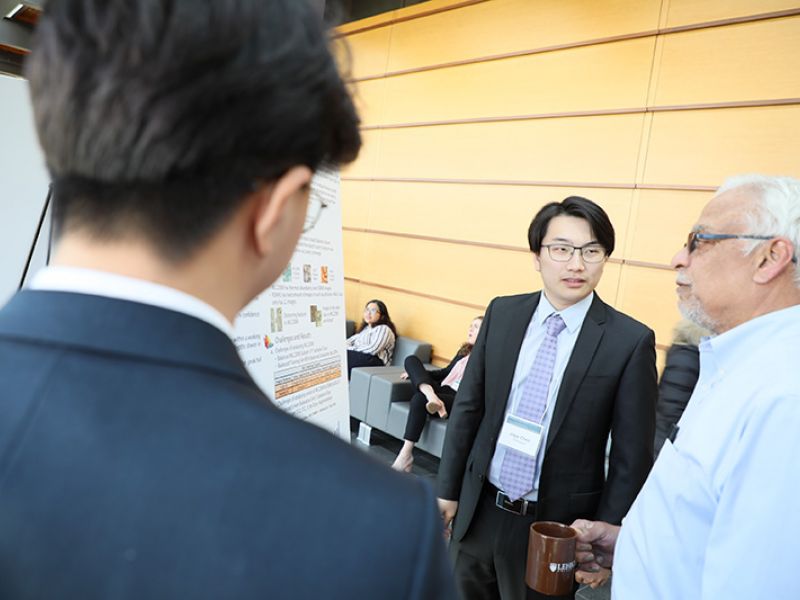VIEW PHOTOS from the 2019 Undergraduate Research Symposium!
Congratulations to this year's Undergraduate Research Symposium winners:
First Place: Joanne Huang, "Anti-bacterial and Anti-toxin Activities of Catechins"
Third Place: Lara Reid, "A Biomimetic Microfluidic Platform for Anti-tumor Drug Evaluation"
Honorable Mention: Challen Adu, "Thermoelectric properties of chalcogenide perovskite"
Honorable Mention: Nahin Ferdousi, "Interaction Effects of Ultrafine Particle Emissions of Multiple Fuse-Deposition Modeling Printers"
Honorable Mention: Nicole Malofsky, "Developing Functionalized Bioresorbable Membranes Using Natural and Synthetic Polymer Blends"
People's Choice Award: Nicole Malofsky, "Developing Functionalized Bioresorbable Membranes Using Natural and Synthetic Polymer Blends"
 3:12 p.m.: Research by Lafayette College senior Nahin Ferdousi, a chemical engineering major, examines the gasses emitted by’ 3-D printers and how they impact health and indoor air quality.
3:12 p.m.: Research by Lafayette College senior Nahin Ferdousi, a chemical engineering major, examines the gasses emitted by’ 3-D printers and how they impact health and indoor air quality.
“During the 3-D printing process, there’s a transition from hot to cold air, and semi-volatile compounds are emitted,” Ferdousi says. “They condense and latch on to each other, becoming ‘sticky’ particles. And when you breathe them in, they can latch onto your respiratory system.”
Although 3-D printers have become increasingly popular, this is an area that hasn’t been studied much, she says. Ferdousi’s research involved putting 3-D printers in a gas chamber and tracking the phenomenon to model it and prove that the interaction happens.
“This is the first step in a longer series of projects,” she says. “We only used one type of material, PLA [polylactic acid], so then the next step is to use another type of material and see how emissions from different polymer filaments interact with each other. And then we’ll want to break down the components and see what the chemicals are. If we know what the chemicals are, we know what we’re breathing in and we know how to remediate the situation.”
Ferdousi continues: “3-D printers are everywhere now. They’re in industry, they are in classrooms, they are in homes. We need to understand the hazards around 3-D printing all together. It’s important for people who are vulnerable, people with asthma, the elderly, infants. If you have a 3-D printer in that kind of setting, you want to know what’s happening.”

The two industrial and systems engineering undergraduates created a neural network in the programming language python and used data from Bloomberg Terminal to predict when stocks will drop.
The input of the model is the price of the stocks and the output is zero, meaning no drop, or one, meaning a drop. After their model runs, they compare the network’s prediction to the actual classification by Bloomberg.
“Artificial Intelligence is hot right now, and also deep learning just makes life easier because you don't have to look at years of data,” Min said.
In addition to testing the model on historical stock data, the duo is using a trade simulation API that runs in the cloud in real time so that they can see how their model performs on current data. Jin, who hopes to pursue a career in financial engineering, said this research helps her understand more about the combination of engineering and business. —Madison Hoff ’19
 1:50 p.m.: “Most countries are moving to renewable energy because its clean energy and its more sustainable, but it creates a lot of fluctuations in the grid and it really makes the grid system volatile,” says electrical engineering major Jasper Chumba ’19. “We want to increase the amount of renewable energy we put into the system, but we want to make the grid system safe at the same time.
1:50 p.m.: “Most countries are moving to renewable energy because its clean energy and its more sustainable, but it creates a lot of fluctuations in the grid and it really makes the grid system volatile,” says electrical engineering major Jasper Chumba ’19. “We want to increase the amount of renewable energy we put into the system, but we want to make the grid system safe at the same time.
Research by Chumba (photo, right), Evelyn Sun ’19 (left, electrical engineering), and Dawon Jeong ’19 (center, computer engineering) looks to develop a test scheme, using machine learning, to detect power attacks disguised as renewable energy.
“Renewable generation opens up an avenue to exploit,” says Jeong. “What an attacker will do is try to imitate what renewable generation is doing. We’re using a model that will take the seasonality of wind, solar, water power into account and from there we will model our own random attack and see if our prediction will catch that attack.”
 11:47 a.m.: Research by Kiana Nieves ’19, a civil engineering student, examines the costs and benefits of transitioning from a prescriptive fire-resistant design in building construction to a newer performance-based approach.
11:47 a.m.: Research by Kiana Nieves ’19, a civil engineering student, examines the costs and benefits of transitioning from a prescriptive fire-resistant design in building construction to a newer performance-based approach.

Engineering student research once again takes center stage today as Lehigh celebrates its 16th year of the David and Lorraine Freed Undergraduate Research Symposium.
The symposium provides an opportunity for undergraduates to share work from a broad spectrum of engineering disciplines; this year, individuals and teams will present on topics including 3D anti-tumor drug screening and power grid cyberattack prevention.
Students will present their research before a panel of judges, who will pose follow-up questions. The presenters will interact with faculty, students, visitors, and staff attending the event throughout the day.
Winners selected by the judging panel will receive scholarships to attend professional conferences. Symposium attendees are encouraged to participate in the event by casting a vote for the People’s Choice Award.
The symposium is endowed by Andrew D. Freed ’83 in honor of his parents. Now retired, Freed most recently served as CEO of Micro-Coax, a manufacturer of electronic transmission devices based in Pottstown, PA. Freed holds a bachelor's degree in metallurgy and materials engineering from Lehigh and a master's degree in industrial administration from Carnegie Mellon University.
The event runs today in the main lobby of the STEPS building from 10 a.m. to 4 p.m., followed by the awards ceremony. Visit the Undergraduate Research Symposium website for additional event details and to read more about this year's competitors.





